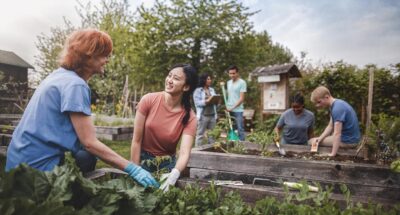
Transforming Challenges into Meaningful Pursuits
Students reflect on a community challenge, and then think of solutions after experiencing an “awe” moment.

Students reflect on a community challenge, and then think of solutions after experiencing an “awe” moment.
(a) leaning into discomfort
(b) non-judgment for themselves and their community members
(c) being curiously and creatively invested in turning the challenge into a meaningful pursuit.
NOTE: You can consider using or adapting this norm-setting exercise with students.
Helping students recognize their agency in leading community change has been found to be a critical factor in motivating them to do so. Indeed, researchers in the Eastern region of the Democratic Republic of Congo where violent conflict is prevalent conducted a series of training sessions for youth that used a strengths-based approach for peacebuilding and social change, and found that shifting young people’s mindset from what “we need” to “what we already have” was most meaningful for participants in helping them recognize their agency, enabling them to lead community change.
Additionally, research during the COVID-19 pandemic has shown that an experience of awe, such as reminiscing times when medical workers kept helping patients even when faced with a threat to their own health, , enhanced participants’ feeling of connection to others and their inclination to donate blood (an indicator of prosociality).
Many students are passionate about making their communities and world a better place—but in order to make a difference, they need to perceive themselves as capable of doing so. Indeed, researchers have found that how young people handle obstacles when pursuing certain tasks is determined by whether or not they believe they can change things.
Exposing students to true stories of people overcoming obstacles can help develop this belief in themselves. Science has found that stories trigger neurochemical processes that not only help students make sense of the world, but also increase real-life empathic skills. Thus, hearing stories of others transforming their fear, isolation, and pain into hope, solidarity, and action can help students develop optimism and agency, which can then be used to transform challenges into meaningful pursuits.
Uplifting stories of others making a difference in the world may also trigger a sense of awe in students, which researchers have found increases students’ prosocial behavior and connection to broader humanity.

Do you want to dive deeper into the science behind our GGIE practices? Enroll in one of our online courses for educators!
Comments